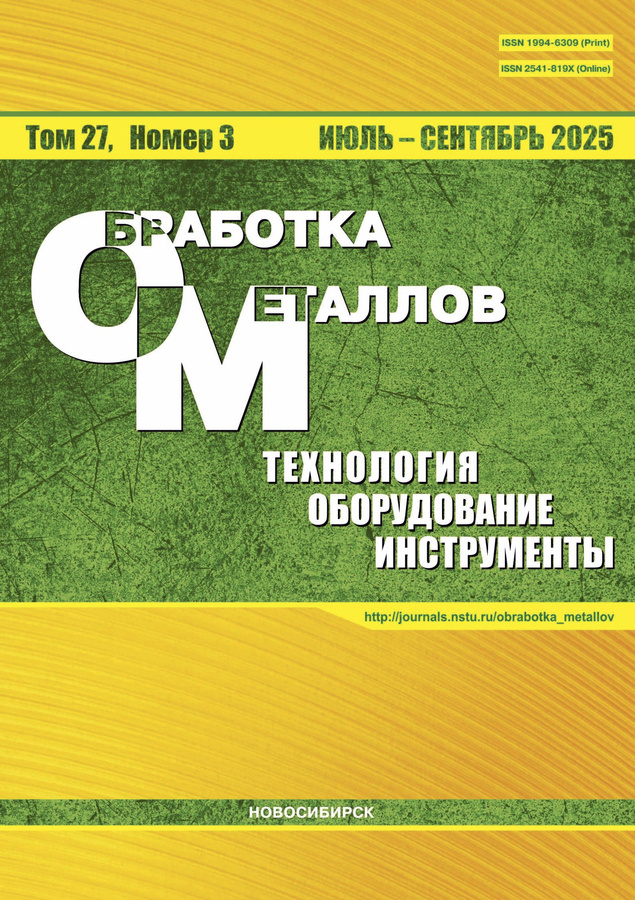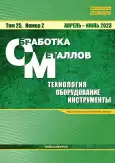Структура и свойства покрытий WC-10Co4Cr, полученных высокоскоростным плазменным напылением
- Авторы: Корниенко Е.Е.1, Гуляев И.П.1, Кузьмин В.И.1, Тамбовцев А.С.1, Тырышкин П.А.1
-
Учреждения:
- Выпуск: Том 25, № 2 (2023)
- Страницы: 81-92
- Раздел: МАТЕРИАЛОВЕДЕНИЕ
- URL: https://journals.rcsi.science/1994-6309/article/view/301444
- DOI: https://doi.org/10.17212/1994-6309-2023-25.2-81-92
- ID: 301444
Цитировать
Аннотация
Ключевые слова
Об авторах
Е. Е. Корниенко
Email: e.kornienko@corp.nstu.ru
канд. техн. наук, Новосибирский государственный технический университет, пр. К. Маркса, 20, г. Новосибирск, 630073, Россия, e.kornienko@corp.nstu.ru
И. П. Гуляев
Email: gulyaev@itam.nsc.ru
канд. физ.-мат. наук, доцент, Институт теоретической и прикладной механики им. С.А. Христиановича СО РАН, ул. Институтская, 4/1, г. Новосибирск, 630090, Россия, gulyaev@itam.nsc.ru
В. И. Кузьмин
Email: vikuzmin57@mail.ru
канд. техн. наук, Институт теоретической и прикладной механики им. С.А. Христиановича СО РАН, ул. Институтская, 4/1, г. Новосибирск, 630090, Россия, vikuzmin57@mail.ru
А. С. Тамбовцев
Email: alsetam123@icloud.com
Институт теоретической и прикладной механики им. С.А. Христиановича СО РАН, ул. Институтская, 4/1, г. Новосибирск, 630090, Россия, alsetam123@icloud.com
П. А. Тырышкин
Email: pavel99730@gmail.com
Институт теоретической и прикладной механики им. С.А. Христиановича СО РАН, ул. Институтская, 4/1, г. Новосибирск, 630090, Россия, pavel99730@gmail.com
Список литературы
- Surface modification of air plasma spraying WC–12%Co cermet coating by laser melting technique / M. Afzal, M. Ajmal, A. Nusair Khan, A. Hussain, R. Akhter // Optics Laser. – 2014. – Vol. 56. – P. 202–206. – doi: 10.1016/j.optlastec.2013.08.017.
- Microstructure and cavitation erosion behavior of WC-Co-Cr coating on 1Cr18Ni9Ti stainless steel by HVOF thermal spraying / Y. Wu, S. Hong, J. Zhang, Z. He, W. Guo, Q. Wang, G. Li // International Journal of Refractory Metals and Hard Materials. – 2012. – Vol. 32. – P. 21–26. – doi: 10.1016/j.ijrmhm.2012.01.002.
- Interdependence of slurry erosion wear performance and residual stress in WC-12wt%Co and WC-10wt%VC-12wt%Co HVOF coatings / A.M. Venter, V. Luzin, D. Maraisa, N. Sacks, E.N. Ogunmuyiwa, P.H. Shipway // International Journal Refractory Metals and Hard Materials. – 2020. – Vol. 87. – P. 105101. – doi: 10.1016/j.ijrmhm.2019.105101.
- Mechanical properties of WC-Co coatings with different decarburization levels / X. Wu, Z.M. Guo, H.B. Wang, X.Y. Song // Rare Metals. – 2014. – Vol. 33, iss. 3. – P. 313–317. – doi: 10.1007/s12598-014-0257-8.
- Microstructure and wear behavior of conventional and nanostructured plasma-sprayed WC-Co coatings / E. Sanchez, E. Bannier, M.D. Salvador, V. Bonache, J.C. Garc?a, J. Morgiel, J. Grzonka // Journal of Thermal Spray Technology. – 2010. – Vol. 19, iss. 5. – P. 964–974. – doi: 10.1007/s11666-010-9480-5.
- Liu S.L., Zheng X.P., Geng G.Q. Influence of nano-WC-12Co powder addition in WC–10Co–4Cr AC-HVAF sprayed coatings on wear and erosion behavior // Wear. – 2010. – Vol. 269, iss. 5–6. – P. 362–367. – doi: 10.1016/j.wear.2010.04.019.
- Wear resistance enhancement of HVOF-sprayed WC-Co coating by complete densification of starting powder / H. Wang, Q. Qiu, M. Gee, C. Hou, X. Liu, X. Song // Materials and Design. – 2020. – Vol. 191. – P. 108586. – doi: 10.1016/j.matdes.2020.108586.
- Influence of the handling parameters on residual stresses of HVOF-sprayed WC-12Co coatings / U. Selvadurai, P. Hollingsworth, I. Baumann, B. Hussong, W. Tillmann, S. Rausch, D. Biermann // Surface and Coatings Technology. – 2015. – Vol. 268. – P. 30–35. – doi: 10.1016/j.surfcoat.2014.11.055.
- Ghadami F., Sohi M.H., Ghadami S. Effect of bond coat and post-heat treatment on the adhesion of air plasma sprayed WC-Co coatings // Surface and Coatings Technology. – 2015. – Vol. 261. – P. 289–294. – doi: 10.1016/j.surfcoat.2014.11.016.
- Yin B., Zhou H.D., Yi D.L. Microsliding wear behavior of HVOF sprayed conventional and nanostructured WC-12Co coatings at elevated temperatures // Surface Engineering. – 2010. – Vol. 26, iss. 6. – P. 469–477. – doi: 10.1179/026708410X12506870724352.
- Effects of the dispersion time on the microstructure and wear resistance of WC/Co-CNTs HVOF sprayed coatings / M.A. Rodriguez, L. Gil, S. Camero, N. Freґty, Y. Santana, J. Caro // Surface and Coatings Technology. – 2014. – Vol. 258. – P. 38–48. – doi: 10.1016/j.surfcoat.2014.10.014.
- Effects of WC-Ni content on microstructure and wear resistance of laser cladding Ni-based alloys coating / C. Guo, J. Chen, J. Zhou, J. Zhao, L. Wang, Y. Yu, H. Zhou // Surface and Coatings Technology. – 2012. – Vol. 206. – P. 2064–2071. – doi: 10.1016/j.surfcoat.2011.06.005.
- Effect of WC-12Co content on wear and electrochemical corrosion properties of Ni-Cu/WC-12Co composite coatings deposited by laser cladding / J. Zhang, J. Lei, Z. Gu, F. Tantai, H. Tian, J. Han, Y. Fang // Surface and Coatings Technology. – 2020. – Vol. 393. – P. 125807. – doi: 10.1016/j.surfcoat.2020.125807.
- Jalali Azizpour M., Tolouei-Rad M. The effect of spraying temperature on the corrosion and wear behavior of HVOF thermal sprayed WC-Co coatings // Ceramics International. – 2019. – Vol. 45, iss. 11. – P. 13934–13941. – doi: 10.1016/j.ceramint.2019.04.091.
- HVOF sprayed WC-Co coatings: microstructure, mechanical properties and friction moment prediction / T. Sahraoui, S. Guessasma, M. Ali Jeridane, M. Hadji // Materials and Design. – 2010. – Vol. 31, iss. 3. – P. 1431–1437. – doi: 10.1016/j.matdes.2009.08.037.
- He J., Schoenung J.M. A review on nanostructured WC-Co coatings // Surface and Coatings Technology. – 2002. – Vol. 157, iss. 1. – P. 72–79. – doi: 10.1016/S0257-8972(02)00141-X.
- Simultaneous increase of friction coefficient and wear resistance through hvof sprayed WC-(nano WC-Co) / P.H. Gao, B.Y. Chen, W. Wang, H. Jia, J.P. Li, Z. Yang, Y.C. Guo // Surface and Coatings Technology. – 2019. – Vol. 363. – P. 379–389. – doi: 10.1016/j.surfcoat.2019.02.042.
- Ghosh G., Sidpara A., Bandyopadhyay P.P. Understanding the role of surface roughness on the tribological performance and corrosion resistance of WC-Co coating // Surface and Coatings Technology. – 2019. – Vol. 378. – P. 125080. – doi: 10.1016/j.surfcoat.2019.125080.
- Dent A.H., Palo S., Sampath S. Examination of the wear properties of HVOF sprayed nanostructured and conventional WC-Co cermets with different binder phase contents // Journal of Thermal Spray Technology. – 2002. – Vol. 11 (4). – P. 551–558. – doi: 10.1361/105996302770348691.
- Baik K.H., Kim J.H., Seong B.G. Improvements in hardness and wear resistance of thermally sprayed WC-Co nanocomposite coatings // Materials Science and Engineering: A. – 2007. – Vol. 449–451. – P. 846–849. – doi: 10.1016/j.msea.2006.02.295.
- Интерметаллидные покрытия Al3Ti, сформированные при помощи холодного газодинамического напыления и термической обработки / Е.Е. Корниенко, А.Д. Вялова, В.С. Шикалов, В.Ф. Косарев, Т.М. Видюк // Обработка металлов (технология, оборудование, инструменты). – 2020. – Т. 22, № 1. – С. 80–89. – doi: 10.17212/1994-6309-2020-22.1-80-89.
- Quantitative evaluation of the decarburization and microstructure evolution of WC-Co during plasma spraying / Q. Zhan, L. Yu, F. Ye, Q. Xue, H. Li // Surface and Coatings Technology. – 2012. – Vol. 206. – P. 4068–4074. – doi: 10.1016/j.surfcoat.2012.03.091.
- Decarburization mechanisms of WCeCo during thermal spraying: insights from controlled carbon loss and microstructure characterization / J. Yuan, Q. Zhan, J. Huang, S. Ding, H. Li // Materials Chemistry and Physics. – 2013. – Vol. 142. – P. 165–171. – doi: 10.1016/j.matchemphys.2013.06.052.
- FIB-SEM sectioning study of decarburization products in the microstructure of HVOF-sprayed WC-Co coatings / V. Katranidis, S. Gu, D.C. Cox, M.J. Whiting, S. Kamnis // Journal of Thermal Spray Technology. – 2018. – Vol. 27. – P. 898–908. – doi: 10.1007/s11666-018-0721-3.
- Fu D., Xiong H., Wang Q. Microstructure evolution and its effect on the wear performance of HVOF-sprayed conventional WC-Co coating // Journal of Materials Engineering and Performance. – 2016. – Vol. 25. – P. 4352–4358. – doi: 10.1007/s11665-016-2278-y.
Дополнительные файлы







